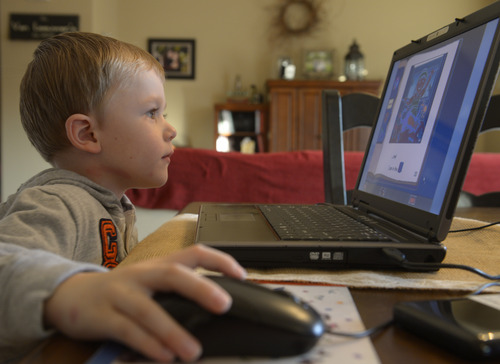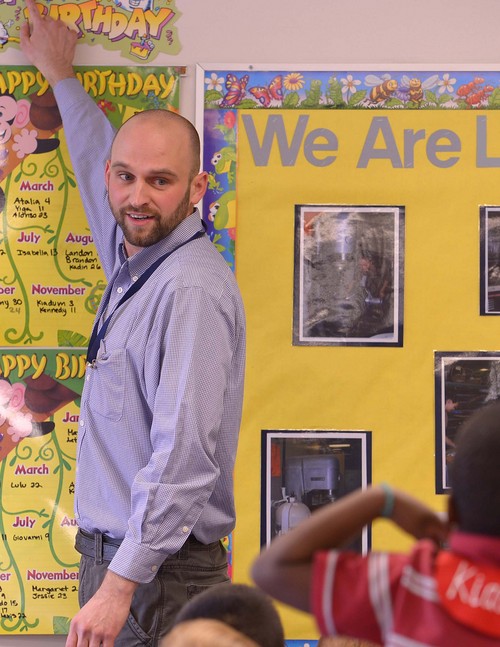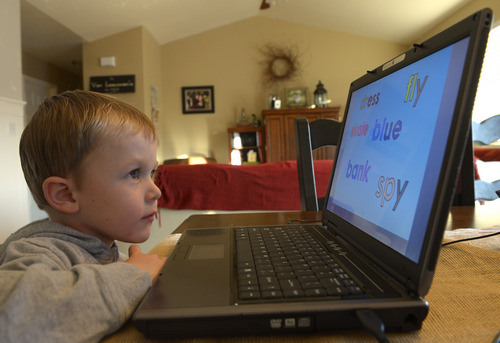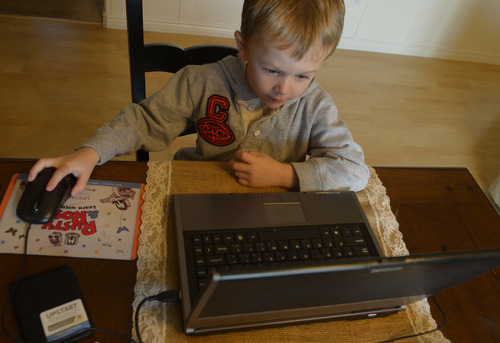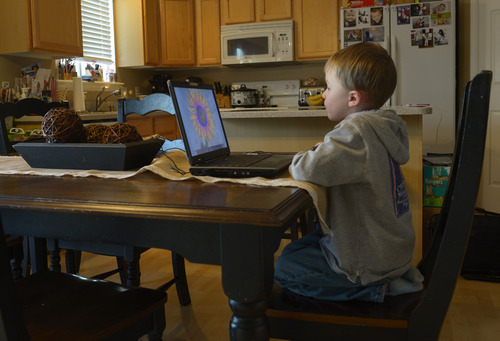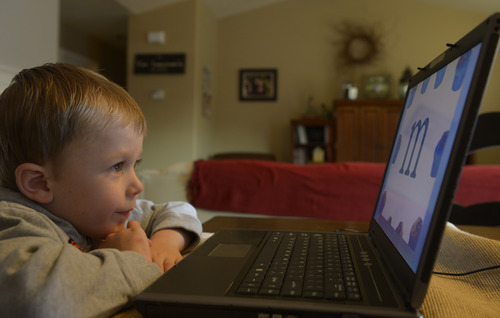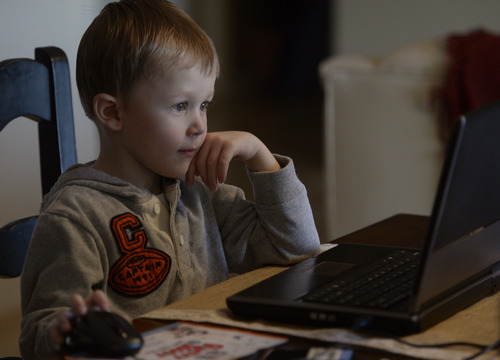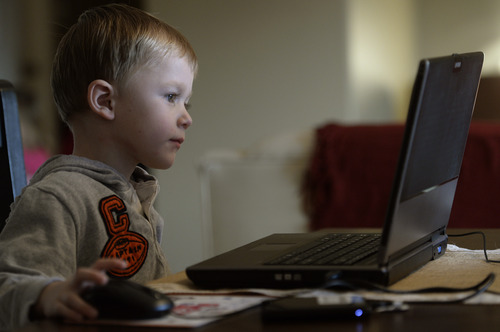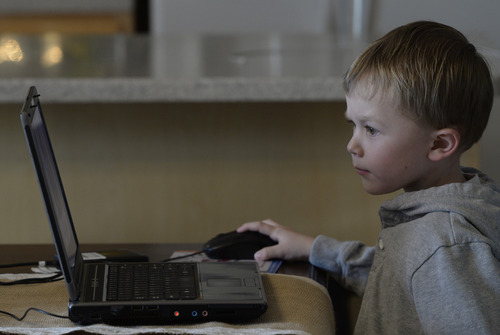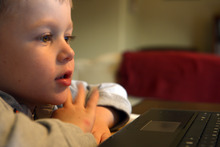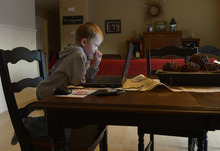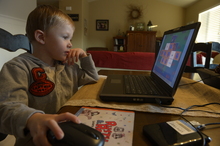This is an archived article that was published on sltrib.com in 2014, and information in the article may be outdated. It is provided only for personal research purposes and may not be reprinted.
On a recent Wednesday, a preschool class at Lincoln Elementary baked mini bread loaves in honor of the book "The Little Red Hen," then acted out the story with animal masks.
That same day, about 15 miles away in West Jordan, 5-year-old Ashton Van Leeuwen sat at the narrow end of his family's kitchen table in front of a laptop computer, singing along to a song about letters as animated images danced on the screen. His mother looked on.
They're two different approaches to preschool that will be in competition for state funding this legislative session.
Despite a long-held wariness of state-funded preschool in Utah, legislative leaders seem to finally agree that early education is key to helping kids succeed. The Legislature's Education Task Force recently recommended supporting early childhood education programs for at-risk kids.
The question is, Which programs?
Proponents of classroom preschool models say they help kids develop emotionally, socially and academically. Supporters of the software approach say it prepares kids for kindergarten while allowing them to stay at home longer.
At least three Republican lawmakers will tackle the issue this year, proposing three solutions.
—
Upgrade for UPSTART? • Sen. Stuart Adams, R-Layton, will ask lawmakers to add at least $1 million to $2 million to existing funding for UPSTART, a software program for use at home. Now in its fifth year of state support, it received $2.2 million for this school year.
An independent evaluation of its third year found UPSTART kids performed, over the course of a year, about two to three times better on early literacy tests than kids who didn't use it.
Waterford Institute, which developed it, recently won a federal $11.5 million Investing in Innovation grant to help expand UPSTART to rural Utah.
But that money won't cover expanding the program along the Wasatch Front, which is why Adams wants more cash. The program is free to families.
About 1,500 Utah kids are using UPSTART, and another 3,700 have already pre-registered for next school year — an upswing in demand that will require more state dollars, said Claudia Miner, UPSTART director at Waterford.
"We consistently have a waiting list, year over year," said Diane Weaver, marketing director with Waterford. "Utah families are ready to see this program expand."
Ashton's mom, Vivien Van Leeuwen, said her oldest son, now 7, started kindergarten at about a first-grade level thanks to UPSTART. Her younger son, Ashton, began reading within weeks of starting UPSTART, which he uses about 25 to 30 minutes a day, she said.
"We were just shocked at how much he was learning, and I also loved that he was doing it on his own," Van Leeuwen said. She has sent her kids to traditional preschool as well, for socialization.
Allisen Smith, on the other hand, said she started her oldest child on UPSTART because her family couldn't afford traditional preschool. The Syracuse mom liked that it customized lessons to her daughter's needs.
"It repeated what was necessary for her," Smith said. "I thought that was fantastic because I know there's no way I could have taught that to her, and I know in a class the teacher would not have had patience going over it and over it again."
—
Classrooms for at-risk kids? • Sen. Aaron Osmond, R-South Jordan, wants $6 million to expand high-quality preschool in classrooms for at-risk kids.
Under his SB42, participating schools also would have computer labs with programs available to families outside school hours. They would contract with private groups, where available, to provide preschool services.
The effort would be modeled on the success of the Granite District's program, which is free to kids from low-income families.
Preschoolers from Granite's 11 poorest schools have significantly outperformed the district's low-income children as a whole as they've progressed through grade school.
Osmond's bill proposes 12 hours a week of preschool for 3-year-olds and 16 hours a week for 4-year-olds.
"What's so exciting about pre-K, especially high-quality pre-K, [is] those programs are having a significant impact on these kids because we're catching them early," Osmond said.
He anticipates the bill would allow the program to expand in about seven districts and charter schools, which would apply for grants.
Lawmakers panned a similar bill Osmond proposed last year, which asked private investors to front the money and committed the state to repaying them if the program was a success.
Goldman Sachs and J.B. Pritzker have since funded programs in Granite and Park City School District. The United Way of Salt Lake promises to pay them back if the programs keep kids out of special education and remediation.
Even with the private funding, Granite typically has 500 to 1,000 kids on preschool waiting lists, said Brenda Van Gorder, district director of preschool services.
—
Inviting investors • Rep. Greg Hughes, R-Draper, thinks Osmond's private investment proposal from last year is worth another shot.
Under Hughes' bill, investors would choose which proven preschool strategies to fund. They could expand classroom programs, pay for software or finance curriculum to be used by existing programs, such as in daycare centers.
A board and a third-party evaluator would ensure quality, and the state would pay investors back with interest if their programs are successful. Hughes wants $5 million set aside for his idea.
"When we look at our budget every year and look at all the needs that are out there, there's just not enough dollars," Hughes said. "If we can leverage private dollars and find ways to avoid enormous costs for these students downstream by seeing them better prepared earlier on, the taxpayer is better served, the child is better served, the education system is better served."
—
Assessing approaches • Though both UPSTART and the Granite model have proved effective, no one has yet directly compared their results. The costs are fairly comparable.
UPSTART costs about $1,300 per child, including giving free computers and Internet to lower-income families, during its fourth year. The Granite classroom program costs about $1,500 a year per 4-year-old and about $950 for a 3-year-old.
Traditional preschool proponents say their approach may lead to more well-rounded children.
"Computers can teach academics, but they can't teach social skills," Van Gorder said. "They can't teach you the things that make you successful in school."
Van Gorder also points out the voluntary program caters to at-risk kids whose parents have already made a choice to put them in preschool.
UPSTART proponents, however, say it allows families anywhere in the state to take part. Also, young kids can stay at home with parents who can teach them the social skills a computer can't.
"We all know how important kindergarten preparedness is and the preschool learning years are," Miner said, "but some families really don't want their children to start any earlier than kindergarten and if they can do it in the home, it fits the children." —
Reaching Utah's kids early
So far, two early education bills have been released:
SB42, sponsored by Sen. Aaron Osmond, R-South Jordan, seeks $6 million to expand high quality classroom preschool for at-risk kids, with additional services available outside school hours.
SB148, sponsored by Sen. Stuart Adams, R-Layton, would convert the pilot UPSTART, software for preschoolers to learn at home, to a permanent program. He also wants an additional $1 million to $2 million a year to expand UPSTART.


